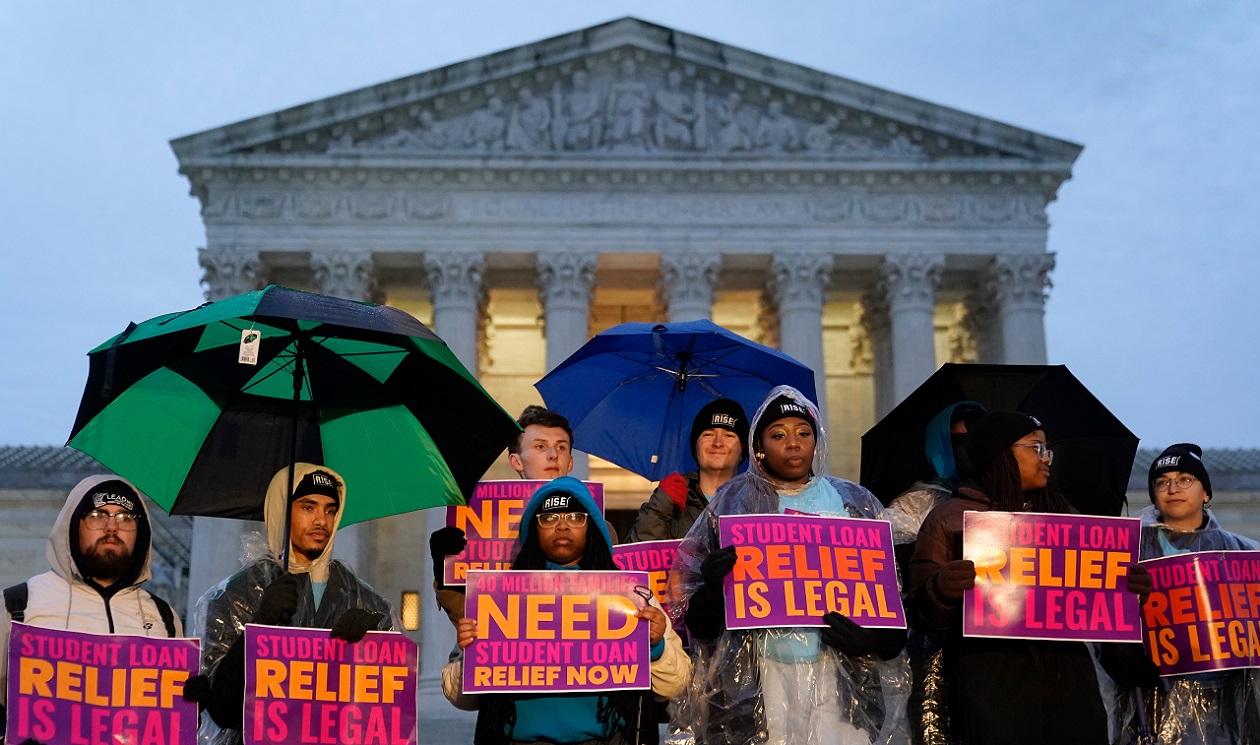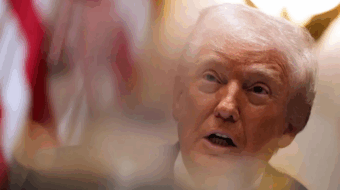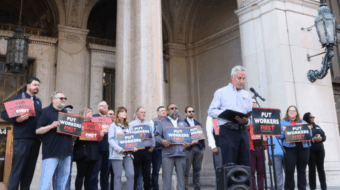
WASHINGTON—The Trump-appointed right wingers on the Court questioned the legality of President Biden’s plan to wipe out more than $400 billion in student debt, making it likely that the Supreme Court will kill his plan to forgive the loans of tens of millions of borrowers.
The Chief Justice accused the president of acting without congressional authority. The liberal justices said Congress had given the president this authority when it passed a law in 2003 that authorized the secretary of education to address emergencies. Recovering from the pandemic and impending collapse of the economy, in the eyes of the administration and the 26 million who have applied for debt relief, was just such an emergency.
In this case, pitting corporate special interests and their political puppets against workers, students, unions, and the Biden administration, the Supreme Court wrestled for at least two hours on Feb. 28 on whether Biden has the legal authority to forgive billions of dollars in student loan debt.
Arguing for Biden, Solicitor General Elizabeth Prelogar told the justices the president “has the clear legal authority to provide relief to borrowers in order to protect them from the financial harms brought on by the pandemic,” CNN reported.
She also said the states—Republican-led—that started the suit to stop Biden’s plan aren’t hurt by it, so they don’t have the right to sue. Essentially, the argument is that they have no standing to even bring the case before the court, and with the right-wing majority in place this may be the best chance there is to save Biden’s plan. It is not considered likely, however, that the justices will go along with this argument.
The justices, especially the Republican-named majority, were skeptical of Prelogar’s basic argument, saying they felt Biden had gone too far, without Congress. The student loans case “presents important issues about the role of Congress” and whether it must be involved and when.
“We take very seriously the idea…that power should be divided to prevent its abuse,” Chief Justice John Roberts said.
While the lawyers debated inside the court’s chambers, the crowd of almost 200 people outside—many of them people of color still carrying student debt—made their position clear: They want and need loan forgiveness.
Union leaders Randi Weingarten of the Teachers (AFT), Mary Kay Henry of the Service Employees, and Becky Pringle of the National Education Association urged the crowd to keep up the campaign for loan forgiveness regardless of what the justices—and especially the Republican-named right-wing majority—eventually decide.
But most of the speakers seemed to assume the court would vote on ideological grounds and toss out Biden’s plan to forgive the first $20,000 of each borrower’s student loan debt.
At the beginning of the coronavirus pandemic, the Education Department suspended student loan debt repayments, recognizing that with millions of borrowers out of work, the debt—now $1.7 trillion, total—would be a crushing burden. Biden’s plan would cancel a quarter of that sum. The banks and debt servicers howled, and have kept howling.
Biden Education Secretary Miguel Cardona, acting at his boss’s behest, planned to forgive the first $20,000, using broad discretion from the Higher Education Act, Weingarten said.
Other advocates, notably Sens. Elizabeth Warren, D-Mass., and Bernie Sanders, Ind-Vt., demand forgiveness of far larger amounts of debt. Sanders wants to forgive all of it.
The lawsuit before the Supreme Court blocked Biden’s plan via lower courts’ rulings–and blocked an estimated 16 million student loan borrowers, so far, from obtaining relief.
And the motives of the foes, (a) corporate greed and (b) opposing Biden, are clear.
“Right now the Supreme Court is hearing the case that could kill student debt relief,” More Perfect Union tweeted.
“Behind the lawsuit is a shady network of conservative oligarchs like the Koch Brothers, the Mercers, and the billionaire founder of Home Depot. They’re working overtime to keep you in debt.”
Hypocrisy on display
“To the scores of politicians and business owners—and even the plaintiff in the case—who benefited” from government-forgiven loans during the coronavirus pandemic, but who oppose forgiving student debt, “your hypocrisy is glaringly on display,” declared Jerika Richardson of the National Urban League.
“When politicians have the authority to get something done,” normally, “the lower courts say, ‘Here’s the law, here’s the authority,’” and that’s the end of the controversy, said Weingarten, a New York City civics teacher who also holds a law degree.
“But we watched the cases” the majority decided “last year, and we’re wondering: ‘Is the Supreme Court going to follow the law, or is the Supreme Court going to follow the special interests?’”
Going to college and staying in college is supposed to be affordable, but, increasingly it is not, Weingarten pointed out. It’s especially unaffordable, from students’ and families’ own resources, for Black women, other speakers said. One of every four Black female college graduates owes tens of thousands of dollars. Only one in eight white males does.
“And when you miss a payment, you’re in foreclosure” or worse, Weingarten said.
The AFT leader was one of several speakers, including both students and lawmakers, who pointed out that the debt burden could last a lifetime, crippling people’s future chances to buy a house or start a family, as the debt pushes down credit ratings and leads to lender turndowns.
Rep. Ayanna Pressley, D-Mass., told of a 76-year-old grandmother still paying off her student loans. An NEA study last year reported the woman was not alone. “Over a quarter of educators ages 61 and up who took out student loans still have a balance, and within that group, more than a third have $45,000 or more left to pay off,” it said.
The first “Generation Z” lawmaker, Rep. Maxwell Frost, D-Fla., 26, said he never finished college because of the specter of crushing student loan debt.
In addition to speaking to the crowd, NEA President Pringle had her union, the nation’s largest, file a friend-of-the-court brief siding with the students. It concentrated on the impact on teachers, who still carry student debt loads from their years getting masters’ degrees, and how many, unable to make ends meet and still pay off the debt on a teacher’s salary, must drop out of the profession as a result.
“Educators today are under an unprecedented level of strain because of the pandemic, its attendant economic upheaval, and an increasingly dire staffing shortage affecting over half of American schools,” the brief argued.
“Nearly half of educators have outstanding student loan debt, owing, on average, $58,700.
“The financial challenges faced by these educators compared to their peers accelerated during the pandemic, but debt relief now would place many educators on more solid financial footing. This relief, though individual, will have implications across the profession as financially secure educators are less likely to leave the profession.”
Whether the justices inside will even consider the popular will outside is unknown. It’ll be known by June 30, the end of the court’s term.











